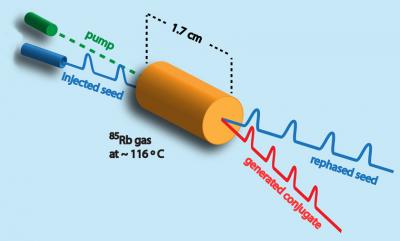The research team from National Institute of Standards and Technology (NIST) has devised a new method to produce superluminal light pulses. This four-wave mixing novel technique re-structures parts of light pulse, followed by their movement beyond a vacuum. This novel method will enhance the timing of communications signals and to examine the propagation of quantum correlations.
 In four-wave mixing, researchers send "seed" pulses of laser light into a heated cell containing atomic rubidium vapor along with a separate "pump" beam at a different frequency. Credit: NIST
In four-wave mixing, researchers send "seed" pulses of laser light into a heated cell containing atomic rubidium vapor along with a separate "pump" beam at a different frequency. Credit: NIST
Einstein's unique theory of relativity states that light passes within a vacuum that represents a universal speed limit. A short burst of light emerges as a type of symmetric curve. The curve’s leading edge cannot surpass the speed of light, but the peak of the pulse can be altered forward or backward.
By increasing the leading edge of the pulse and by cutting the back end, uninformed faster-than-light pulses with increased noise are generated. However, four-wave mixing generates less noisy, rapid and cleaner pulses by rearranging or re-phasing the pulse-generating light waves.
In four-wave mixing, laser light "seed" pulses up to 200-ns long are introduced into a heated cell having atomic rubidium vapor and a separate pump beam of various frequencies beyond the seed pulses. The seed pulse is amplified by the vapor, shifting its peak forward making it superluminal. The photons from the inserted beams undergo concurrent interaction with the vapor giving rise to a second pulse known as "conjugate" due to its statistical link with the seed. The speed of the peak is based on the optimization of laser.
This experiment demonstrates that pulses’ peaks emerged 50 ns quickly than light traveling across a vacuum.
Quantum discord shows the sharing of quantum information between two correlated systems such as the conjugate and seed pulses. Transmission and processing of quantum data based on this accelerated light can be achieved by evaluating quantum discord between reference beams and fast beams.
Source: http://www.nist.gov/